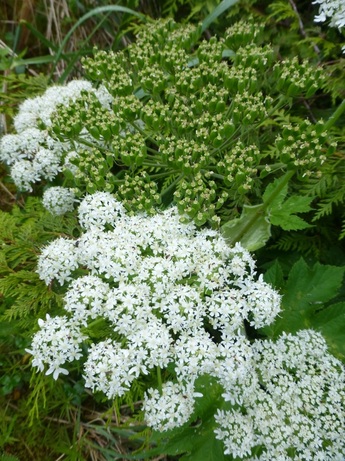Cow-parsnip, common cowparsnip • Heracleum maximum, H. lanatum
 Photo by Ian Cruickshank
Photo by Ian Cruickshank
Identification
This large leafy perennial reaches 1-3 m tall with a single hollow stem. Its large hairy leaves are composed of three lobed and/or toothed leaflets (each to 40 cm long); the leaflets and upper leaves tend to have a maple leaf-like appearance. The leaf stalks inflate where they intersect with the stem. Many small white flowers form a large, flat, umbrella-shaped cluster atop the stem. Mature cow-parsnip emits a strong smell. NOTE: if unsure about identification please consult Plants of Coastal British Columbia, E-Flora BC, or another guide book before touching the plant (see 'Similar Species' below).
Habitat & Range
Cow-parsnip grows in open and disturbed locations from sea level to the alpine zone. Habitats include along streams, beaches, and roadsides, as well as in marshes, meadows, and avalanche tracks. It is a common species in BC and is found across much of North America as well as eastern Asia.
Similar Species
WARNING: similar species include Douglas' water-hemlock (Cicuta douglasii), poison-hemlock (Conium maculatum), and giant cow-parsnip (Heracleum mantegazzianum), which are all large, leafy, and bear clusters of small whitish flowers; the first two species are extremely poisonous and can be differentiated by differences in leaf shape, while the latter can cause severe blistering and rashes when in contact with skin that is then exposed to sunlight. Please see the corresponding E-Flora BC species pages for more ID information.
Human Uses
The outer skin of this species contains furanocoumarins, which can damage skin via phototoxicity; however peeled stalks and leaf stems are a traditional food of coastal First Nations groups. With this in mind, please take note of its phototoxicity and similarity to extremely poisonous plants noted above.
This large leafy perennial reaches 1-3 m tall with a single hollow stem. Its large hairy leaves are composed of three lobed and/or toothed leaflets (each to 40 cm long); the leaflets and upper leaves tend to have a maple leaf-like appearance. The leaf stalks inflate where they intersect with the stem. Many small white flowers form a large, flat, umbrella-shaped cluster atop the stem. Mature cow-parsnip emits a strong smell. NOTE: if unsure about identification please consult Plants of Coastal British Columbia, E-Flora BC, or another guide book before touching the plant (see 'Similar Species' below).
Habitat & Range
Cow-parsnip grows in open and disturbed locations from sea level to the alpine zone. Habitats include along streams, beaches, and roadsides, as well as in marshes, meadows, and avalanche tracks. It is a common species in BC and is found across much of North America as well as eastern Asia.
Similar Species
WARNING: similar species include Douglas' water-hemlock (Cicuta douglasii), poison-hemlock (Conium maculatum), and giant cow-parsnip (Heracleum mantegazzianum), which are all large, leafy, and bear clusters of small whitish flowers; the first two species are extremely poisonous and can be differentiated by differences in leaf shape, while the latter can cause severe blistering and rashes when in contact with skin that is then exposed to sunlight. Please see the corresponding E-Flora BC species pages for more ID information.
Human Uses
The outer skin of this species contains furanocoumarins, which can damage skin via phototoxicity; however peeled stalks and leaf stems are a traditional food of coastal First Nations groups. With this in mind, please take note of its phototoxicity and similarity to extremely poisonous plants noted above.
References
Heracleum maximum Bartram. In Klinkenberg, Brian. (Ed.). E-Flora BC: Electronic Atlas of the Plants of British Columbia. Lab for Advanced Spatial Analysis, Department of Geography, University of British Columbia, Vancouver. Accessed 23/12/2014.
Pojar, J. and MacKinnon, A. (1994). Plants of Coastal British Columbia. Vancouver, BC: Lone Pine Publishing. P. 213.
Authors and editors of page
Kelly Fretwell, Ian Cruickshank, and Brian Starzomski (2014).
Heracleum maximum Bartram. In Klinkenberg, Brian. (Ed.). E-Flora BC: Electronic Atlas of the Plants of British Columbia. Lab for Advanced Spatial Analysis, Department of Geography, University of British Columbia, Vancouver. Accessed 23/12/2014.
Pojar, J. and MacKinnon, A. (1994). Plants of Coastal British Columbia. Vancouver, BC: Lone Pine Publishing. P. 213.
Authors and editors of page
Kelly Fretwell, Ian Cruickshank, and Brian Starzomski (2014).



